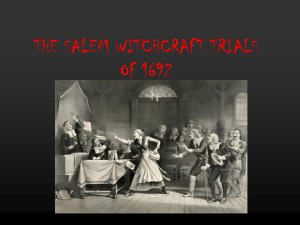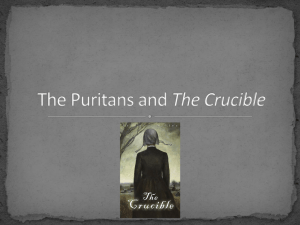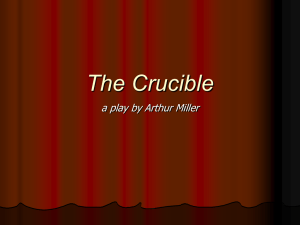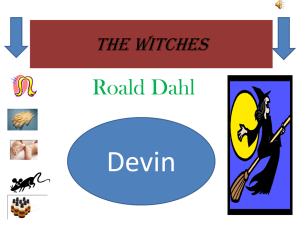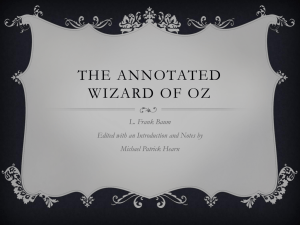The Story of the Salem Witch Trials
advertisement
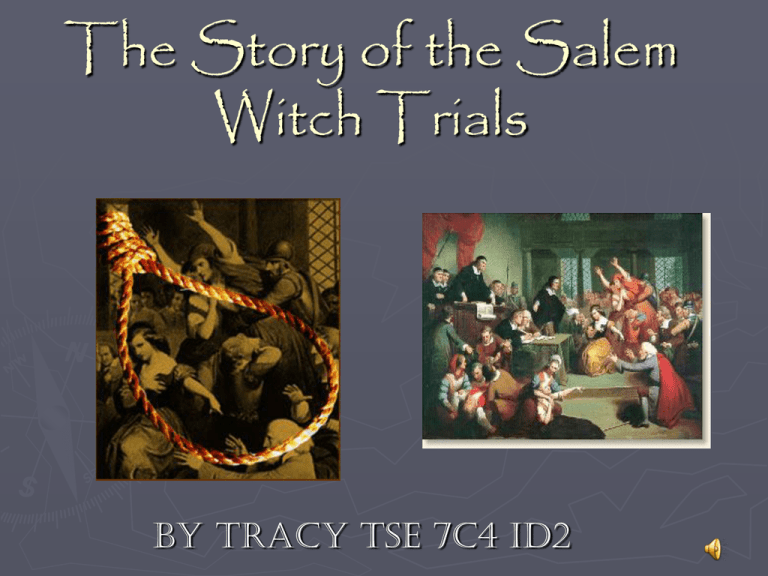
The Story of the Salem Witch Trials By Tracy Tse 7C4 ID2 Salem Witch Trials- What was it? In 1692, there was a lot of panic in a little town called Salem. Many people, at that time, were thought to be working for Satan, or the devil. These people were called witches. In that year, there was a large witch hunt. It led to the death of 24 people. Here was the Salem Witch Trials. Before the Beginning Back in Europe, in 1485, Pope Innocent VII announced to many European countries that witchcraft wasn’t a myth. It was reality! This started a huge witch hunt in Europe. Many people assumed women were witches since they were weak and it was easier for Satan to possess the weak. England passed a law making witchcraft illegal and that all witches were to be killed. Massachusetts was an English colony so the law applied to them, too. There was a lot of controversy in Salem. The western part of Salem wanted to form their own community but the eastern side disapproved of that since many people in the eastern side had jobs involving sea trade. Some of the families in the western side formed a new church since that was a very important step to the establishment of a new town. The minister was Samuel Parris. There was a lot of fear for Indian attacks in Massachusetts. Many towns were being attacked by American Indians. The Beginning Samuel Parris had a daughter named Elizabeth (Betty) Parris and a niece named Abigail Williams. Since Parris’s wife was often sick, Tituba, a Caribbean slave, took care of the two girls. The two girls had a boring life. They started playing a game where they poured an egg white into a cup of water. The egg white would take the shape of something that would determine their future husband’s job. One day, the egg white took the shape of a coffin. After that, the girls started having fits. Dr. William Griggs, their doctor, said the two girls were bewitched. The two girls accused Tituba of bewitching them. The Beginning cont. Later, two other bewitched girls accused Sarah Good and Sarah Osborne of witchcraft. The three women were put on trial. Sarah Good and Sarah Osborne both denied they were witches. Tituba confessed however. She admitted that the devil came to speak to her and appeared to her as a hog, a dog, a black cat, or a rat. She even said that Good, Osborne, and her signed a book from the devil showing that they were now witches for Satan. This was the start of the Salem Witch Trials. Important People Deodat Lawson was a minister in Salem. He told many people in Salem Village that God allowed Satan to come into Salem to harm the girls. He told the people that God was punishing Salem for not following his rules and teachings. Later on, Samuel Parris spoke to the members of his church. He said anyone, even a person that is loyal to God and Jesus, can be a witch. Because of Lawson and Parris, people started to panic and get suspicious of others. Increase Mather and his son, Cotton, were ministers in Boston. The Salem witch trials caught their attention. They both believed that events in life could be influenced by witches and Satan. Cotton Mather believed that judges shouldn’t rely on evidence about ghost claims. He believed that judges should search for physical marks which he called “devil’s marks” to prove someone’s a witch. Examples of “devil’s marks” are moles and warts. Judges started stripping accused witches publicly to look for “devil’s marks.” • • • Trials of Importance After Tituba’s trial, a teenager named Abigail Hobbs confessed that she was a witch. Hobbs was one of the many accused witches that didn’t come from Salem. Hobbs said she met Satan several times when she lived in Maine (Maine was part of Massachusetts back then). In Maine, there were many attacks to the settlers by the Wabanaki Indians. This led people to believe that the American Indians worked for Satan unless they converted to Christianity. The first witch trials started with Bridget Bishop. Many people claimed to have seen her as a ghost threatening them. Bishop denied that she was a witch. She was hanged on June 10, 1692. People started to question the witch trials when Rebecca Nurse, a 71-year old woman, and Dorcas Good, a 4-year old girl, was accused of witchcraft. Rebecca Nurse was one of the most unlikeliest person to be a witch. She was known to be a kind, loving, gentle, and loyal Christian. Nurse’s family formed a petition and collected signatures from the people who knew in their hearts that Rebecca Nurse was a good Christian. Nevertheless, Nurse was hanged in July 19, 1692. Dorcas Good was Sarah Good’s daughter. She wasn’t hanged, but she was in the witch jail for a long time. Trials of Importance cont. George Burroughs was a minister and surprisingly, he was accused for being a witch. Many people defended him, but he was sentenced to death anyway. Before his hanging, Burroughs recited a Christian prayer. This surprised the people of Salem because they believed witches couldn’t recite prayers correctly. They believed that witches recited their prayers backwards in their Sabbaths. People wondered if he was really a witch. Them Cotton Mather pointed out that the jury already found him guilty. Burroughs was hanged on August 19, 1692. Martha Corey and Giles Corey were both respected people of the Puritan church. They were known to be good Christians. It shocked a lot of people when they were put on trial. Martha Corey denied she was a witch. She was hanged on September 22, 1692. Giles Corey refused to say anything in the trial. He was pressed to death. He laid flat on his back and officials placed a board on him. They piled stones on the board until Corey died from the immense weight. It was September 19, 1692. The End of the Salem Witch Trials Let’s give a warm welcome to Thomas Brattle. He was a Boston merchant and scientist. He disapproved of the Salem witch trials. One of the things he didn’t find “scientific” about the trials was the “touch test.” The “touch test” was when a bewitched person touches an accused witch to see if the accused person was really a witch. People believed that if a bewitched person touched a witch, Satan’s power would come back to the witch. Thomas Brattle wrote his criticism about the trials in a public letter. Ministers started to go against the trials. Finally, Governor Phips of Massachusetts ended the trials. Massachusetts lawmakers then formed a new court to hear all the cases of all the accused witches that were still awaiting their fate. Almost all the accused witched had been released and freed since the court didn’t rely on evidence based on ghost claims. Governor Phips apologized to all the accused witches. Even though it has been years since the Salem Witch Trials, and many people now know that witches are fictional, the story of the Salem Witch Trials still fascinate many people. I hope you found the story of the Salem Witch Trials interesting, too. THANK YOU FOR WATCHING! Here are my sources: Research: The Salem Witch Trials by Stuart A. Kallen The Salem Witch Trials by Michael Burgan FAQ’s About the Salem Witch Trials http://www.salemwitchmuseum.com/education/faq.shtml The Salem Witch Trials of 1692 http://www.mayflowerfamilies.com/enquirer/salem_witch_trials.htm The Salem Witch Trials,1692 http://www.eyewitnesstohistory.com/salem.htm The Salem Witch Trials http://kids.nationalgeographic.com/kids/stories/history/salemwitch-trials/ Pictures: http://www.eyewitnesstohistory.com/images/salem1.jpg http://russeyfamily.com/noose.jpg http://www.lookingglassreview.com/assets/images/The_Salem_Witch_Trials.jpg http://library.thinkquest.org/J0110384/pictures/witchpicture01.gif http://salem.lib.virginia.edu/images/Parris.jpg http://www.talesoferotichorror.com/tituba.jpg http://www.hauntedamericatours.com/ghoststories/GallowsHillGhosts/images/tituba

